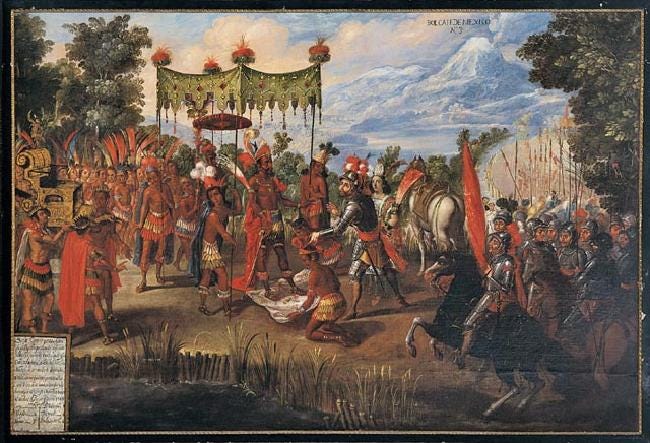How soon is now: Why the Conquest of Mexico still matters
Over 500 years after the fall of Tenochtitlán, the Spanish conquest of Mexico continues to have modern-day relevance for a world that is still largely built in the mold of its consequences

Can’t go back, won’t move on from: The Spanish conquest of Mexico
Our first season of the podcast is going to focus on an event that is near and dear to my heart: the Spanish conquest of Mexico. It is perhaps the defining moment in the early colonization period of the Americas—even more so than Columbus’s voyages in which he first landed on the Caribbean islands of Hispaniola, Jamaica and Cuba. The Spanish conquest of Mexico was the culmination of the entire early period of this colonizing process as the unique melding of private entrepreneurship backed by the Spanish crown (which largely did not know what to make of its new holdings) carved up most of an entire hemisphere.
The result was one of the most significant shake-ups in world history in geographic, demographic and economic terms—with obvious results still lingering on today.
It is also an excellent event to study. Over 150 of the Spanish conquistadors left some form of primary evidence recounting their time in the conquest—most famously Hernán Cortés and Bernal Diaz—each with their own unique axe to grind, while indigenous sources fuse Nahua cultural traditions of storytelling with Spanish-style record-keeping, preserving their own feelings and psychic remembrances on the matter. It makes for a relatively self-contained subject with clear boundaries for historical study and one, with any luck, that offers itself up for being relived for an audience in 2025 and beyond.
Why the Conquest of Mexico still matters
So why does the Conquest of Mexico still matter?
For one thing, its consequences are still evident today from a look at a modern-day map. Much of Central and South America’s existing countries conform to the boundaries created by the Spanish Empire during its 300-year-plus colonization of the hemisphere. These boundaries only began to be formed after the Spanish conquered the Aztec Empire and began to expand their influence across North and South America.
But the empire’s influence expands beyond some names and lines on a map. The Spanish used Mexico as the central spoke in a wheel of trade that connected Europe to the Americas to East Asia, linking together the Atlantic and Pacific Oceans in a truly globe-spanning network of trade that had never been seen before. Silver mined in Spanish America was traded in the Philippines to Chinese merchants for East Asian goods which were then shipped back to Europe, all under the auspice of the Spanish monopoly. All of this kick-started by the Spanish patronage of the Columbus expeditions beginning in 1492.
This network of trade and people created an era in human history known, as Charles C. Mann put it in his book 1493, a Homogenocene, a term which, “refers to homogenizing: mixing unlike substances to create a uniform blend.”
What happened in Mexico after the conquest?
Accounts of the Spanish conquest tend to stop with the fall of Tenochtitlán in 1521, but for those who lived through it—as it is for those who live through any historical moment—life does not start and stop between bookending dates on a calendar.
Though Spain conquered much of the Americas in the following 300 years after Columbus’s initial voyage, few areas of the empire were as intensely cultivated, administered and colonized as Mexico.
Long the realm of Mesoamerican powers from the ancient Olmecs to the culturally-dominant Toltecs and mysterious Teotihuacanos, it was dominated by the Aztec Triple Alliance at the time of the Spanish arrival. Relative newcomers to the area, the Aztecs nevertheless drew on a self-created origin mythology that saw them as both travelers from the semimythical Aztlán and as inheritors of the great traditions of the Central Valley their empire expanded from. In 1519, the year of Spanish arrival, Aztec leader Moctezuma II could have been described credibly as having led the empire to its zenith.
In just two years, it would be totally dismembered.
But though the Spanish succeeded in destroying the Aztec Empire, the indigenous people the empire had dominated persisted. They did not simply disappear, though their numbers did suffer significantly in the wake of Spanish diseases, cruelties and enslavement.
As is so often the case when two groups of people encounter one another, they began to mix. The white Spanish Europeans and the indigenous Americans began to intermarry and intermix, producing a mestizaje race that still today defines the Mexican nation. Many racial divisions and mixtures would take place with races from all around the world, being categorized in a complicated casta system that was long used to enforce social and racial divisions.
How does the conquest impact Mexico today?
Though Mexico finally established itself as an independent entity in the 1820s after throwing off the Spanish yoke following a decade of war for independence, the legacy of the period of colonization left deep impressions and divisions that last to this day.
The complicated racial stratification that defined the colonial period was officially abolished, but in practice it remained ever-present in the deeply conflicted politics of the new nation. As conservatives and liberals jostled for power in Mexico for first 50 years of its independence, many of these political and military battles fought for power often broke down on lines that had been roughly drawn between those who wished to emulate the colonial Spanish government and those who wished to break with its legacy—but even these reductive distinctions ignore the millions of indigenous and mestizo Mexicans who were of neither side and wished to have their own say in how their lives were lived and administered.
Even today, the effects of the Conquest can be felt in Mexican politics. When the 500th anniversary of the Conquest came in 1521, thenPresident Andrés Manuel López Obrador not only issued a state apology to indigenous Americans, but also demanded an apology from the Spanish government.
What can be learned from the conquest in the 21st-century?
Despite its momentous importance to Mexico in particular, the Spanish conquest—as we’ve seen—remains an important historical moment worthy of study for all of us today. The effects of globalized trade still produce vicious inequalities and political battles across the world. When NAFTA went into effect on 1 January 1994, the Zapatista National Liberation Army put the southernmost region of Mexico into armed rebellion and kickstarted a resurgence of anticapitalist movements and reactions that has only intensified in the years since.

But it also serves as a precedent for the ways in which mass migration and demographic challenges and collapse can be understood. The collapse of the indigenous population due to disease and abuse was nothing short of an apocalypse for these peoples—but it was also an uneven process and one that surviving members of those communities were able to adapt to over time using strategies of survival and assimilation.
As our own century presents us with a scenario of climate-induced mass migration over the next several decades and beyond, these strategies of cultural preservation and demographic assimilation have not only historical merit, but contemporary as well.
The reverberations of past lives continue to echo through the present. It’s up to us to find a way to tune in sensitively enough to register what is trying to be communicated and understood.




